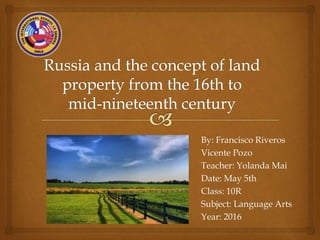Russia and the concept of Land Property
- 1. By: Francisco Riveros Vicente Pozo Teacher: Yolanda Mai Date: May 5th Class: 10R Subject: Language Arts Year: 2016
- 2. ? ? Introduction ? Timeline ? Explanation of land concept in Russia ? Systems used ? Conclusion Index
- 3. ? Our presentation will be about the concept of land property for Russians and the systems that were used. Introduction
- 4. ?
- 5. ? ? Land has always been a central social and economic force for Russia. ? Until the beginning of the twentieth century, state property was the predominant form of property ownership. Land concept in Russian history
- 6. ? ? The open-field system was the prevalent agricultural system of Russia. ? The strips or selions were cultivated by individuals or peasant families, often called tenants or serfs. ? The Lord of the Manor, his officials, and a Manorial court administered the manor and exercised jurisdiction over the peasantry, who only worked for food, they weren¡¯t paid. ¡°Open Fields system¡± or ¡°Russian Peasant Communes¡±.
- 7. ?? The ¡°MIR¡± or ¡°Obshchina¡± (§Þ§Ú§â) was usually used to denote a local, self- governing peasant community. ? This system began more or less in 1724. ? In this system the land was given to the community of peasants not to individual people. ? The village assembly decided what crops to grow, this means that everything must be done at the same time in the same manner ? This communities had to pay excessive taxes to the goverment. ? It was only in 1906 that the Stolypin reforms began destroying the ¡°Obshchinas¡±. MIR or Obshchina system Illustration of what an Obshchina might have looked like.
- 8. ? With this presentation we learned how Russian land property systems worked between the 1500¡¯s to 1850¡¯s, and how important they were for the country Conclusion Russian peasant village in winter








